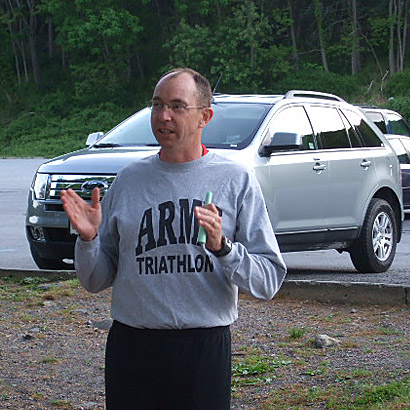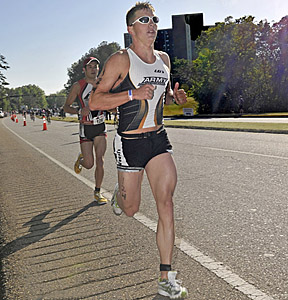West Point Triathlon: Inside the Military Multisport Machine
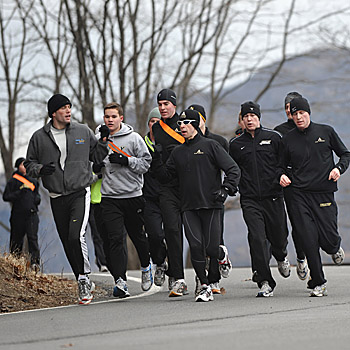
The skies were dull frozen charcoal, cloaking West Point’s neo gothic granite castles in late winter gray as two dozen members of the United States Military Academy triathlon team took off on a little Sunday run. Under the eye of their coach, West Point grad and former pro triathlete Tony DeBoom, the fast-improving men who had finished second and women who had finished sixth at last year’s Collegiate Nationals ran into a stinging wind on a 22-degree day. Just a day after a 4-hour round trip bike south to the hilly Seven Lakes region, everyone who wasn’t injured embarked on a 5k time trial that would serve to mark progress toward a dreamed-of national title.
With some eyes blank with effort, the triathlon team members ran out along the Hudson River, and back to the outdoor track under a light dusting of snow. Team captain senior Nick Vandam led the Army triathletes back to the finish in a near-personal best 16:13, top men Brian Lagasse, Rob Sherry and Nick Sterghos finishing around 17 to 18 minutes, and 2008 National Collegiate Championship women’s 19th place finisher Randy Wintermantel clocking in about 19 and a half minutes. With runners’ efforts gauged by bright red cheeks and snot streaming from frozen noses, they ran on a day that in no way resembled the heat that awaited them April 19 at the 2009 Collegiate Nationals in Lubbock.
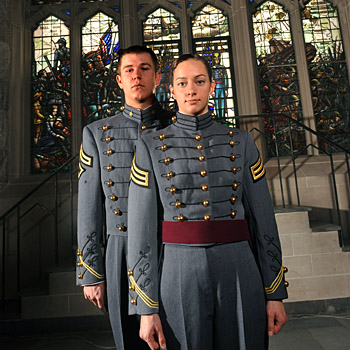
The setting seems far away from the casual, warm roots of the sport born in the 1970s in San Diego and Hawaii. Within this hallowed military garrison founded in 1789, watched over by monumental statues of Generals George Washington, Dwight Eisenhower and Douglas MacArthur, the cream of the nation’s military have been educated here since 1802.
Of the approximately 65,000 graduates that comprise West Point’s Long Gray Line, there have been a wide range of military leaders from bad to brilliant to immortal national heroes. The nation’s first great traitor, Benedict Arnold, was commander of West Point, and cruel 20th century Nicaraguan strongman Anastasio Somoza was also a graduate. There are plaques noting that young, headstrong George Armstrong Custer, who led his men to slaughter at Little Big Horn, and the tactically brilliant World War II hero, General George Patton, both studied there. During the Civil War, Confederate General Robert E. Lee and Union Generals Ulysses S. Grant and William Tecumseh Sherman received West Point educations before leading opposing armies in the War Between the States. In a kind of democracy in death, stubbornly conservative Vietnam War General William Westmoreland and the carelessly impetuous Custer share the West Point Cemetery with 16 Medal of Honor winners. Generals Norman Schwarzkopf, the leader of Allied forces in the Gulf War, and David Petraeus, hailed as the leader behind the recent Iraq surge, have no monuments but are held in high regard in current military history courses.
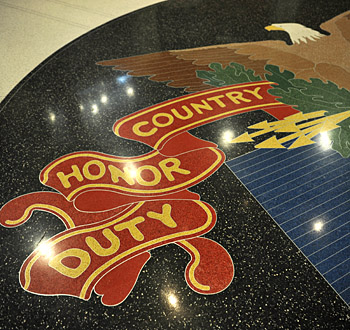
Nowhere else in this country are West Point’s values of Duty, Honor Country embodied with more palpable spirit. Everywhere there are plaques reminding cadets of the sacrifices of their predecessors. In the Civil War, 10 percent (105) of the living West Point graduates were killed. Nearly five hundred West Point graduates died in World War II, 157 perished in the Korean War, 273 died in Vietnam and, by one recent count, 67 have been killed in operations in Iraq and in the global war on terror.
Amid the heavy military traditions and responsibilities for defending the nation omnipresent at the Academy, the joys of sport have also play a key role in preparing the soldier. Famously, the Duke of Wellington (not a West point grad) said “The Battle of Waterloo was won on the playing fields of Eton.” General Douglas MacArthur (West Point grad), with a grandiloquence that revealed his ego while obfuscating his message, echoed that sentiment: “Upon fields of friendly strife are sown the seeds that upon other fields, on other days, will bear the fruits of victory.”
Sport’s role in honing great soldiers was epitomized by West Point All-American football receiver Pete Dawkins, who captained the undefeated 1958 Army football team which ranked third in the nation, won the 1958 Heisman Trophy, and was chosen to be a Rhodes Scholar. Dawkins earned a Bronze Star and Vietnamese Cross of Gallantry for bravery under fire in the Vietnam War, and rose to Brigadier General.
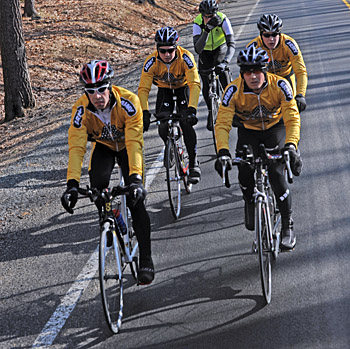
Certainly the relatively modern sport of triathlon has had a military connection from the very beginning. Navy Commander John Collins, who with his wife Judy founded the original Iron Man Triathlon in 1978, says that 9 of the original 15 Ironman starters had military ties, including winner Gordon Haller, a former Navy man, runner-up John Dunbar, a former Navy SEAL, and active duty Marine Henry Forrest. Arising at virtually the same time is perhaps the longest continuously run triathlon on the US mainland. The 31-year-old Super Frog half Ironman-distance event, run near Navy SEAL training headquarters on Coronado Island in San Diego, has been run for years by former Navy SEAL Moki Martin.
And that military connection to triathlon is international. European stars Olivier Marceau, Thomas Hellriegel, Normann Stadler, Dimitry Gaag and many more all won triathlon titles while serving in their nation’s militaries.
While Navy may lead all military branches with its pioneer contributions to triathlon, the Army has some strong candidates for a military triathlon hall of fame as well. Curtis Alitz, a 1978 West Point graduate with a 28:36 best in the 10,000 meter run and a 2:17 best at the marathon, outran Scott Tinley in the stretch to place second in the 1984 US Elite Triathlon Nationals. Michael Hagen, a 1984 West Point graduate, won six US Military Olympic distance Triathlon titles from 1997-2002, and holds an 8:51 Ironman PR at Austria when he was 40. Heidi Grimm, a 1989 West Point grad, also won six US Military Olympic distance titles, won the 2006 Best in the US overall amateur title, and was a member of the Army World Class Athlete Program during her unsuccessful quest to qualify for the 2008 US women’s Olympic Triathlon Team. Current West Point Triathlon coach Tony DeBoom, an All-American in swimming and a top water polo player while at the Academy, won Ironman Utah in 2002 and took wins at the prestigious St. Anthony’s and Chicago Triathlons in a pro career which ended in 2004. And, while he withdrew from West Point and transferred to the University of Iowa before his sophomore year, Tony’s brother might be included in the same spirit that most biographies note that Microsoft billionaire Bill Gates was a Harvard dropout – as was rocker Gram Parsons. For the record, Tim DeBoom won two Ironman World Championship titles in 2001 and 2002.
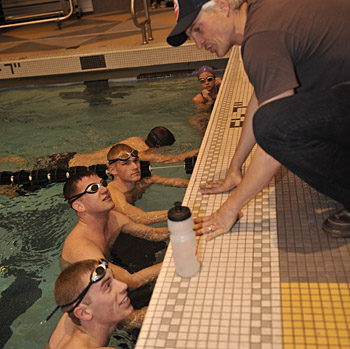
While triathlon remains a club sport and came late to the storied sporting traditions at West Point, this sport most associated with palm trees and tropical climes seems to have become a good fit with the military nature and purpose of the Academy.
“Triathlon fits really well into the military lifestyle,” said junior Brian Lagasse. “To be a successful triathlete, you have to be so disciplined and create a set life schedule, a disciplined regimen. Cadets are so used to that, I think that is part of it. And we are used to pushing ourselves in military training, it’s an ingrained habit.”
“Most people at West Point are Type A personalities, but we triathletes are super Type A personalities,” said senior cadet Randy Wintermantel. “We enjoy pushing ourselves and working really hard to reach our limits.”
“Academy life demands that you manage your time well, and triathletes somehow put in 14 to 18 hours of training a week on a top of a rigorous load of study and other duties,” said junior Ashley Morgan, who also is a top competitor for the Division I cross country and track teams. “Even though the morning swims and afternoon rides and runs take a lot of time, it’s a great balance to cadet life. It’s like a family. We go bowling, we have parties, and we have a lot of fun together. It’s a great stress relief for me and keeps me going.”
“I look at West Point as the best place for an up and coming triathlete,” said team captain Vandam. “They give us food, they give us shelter, and we don't have to worry about a job. We get a full scholarship whether we are on an NCAA team or simply a part of the Corps of Cadets. And we have phenomenal athletic facilities, great coaching resources, and great hills to ride and trails to run on.”
Recent West Point graduate Nick Dason, the 2007-2008 US Military Academy Triathlon captain, says, “There are so many people in the military and the Army who are so active in triathlons and endurance sports because they generally like physical challenges and our sport has a great correlation to the jobs in the Army.”
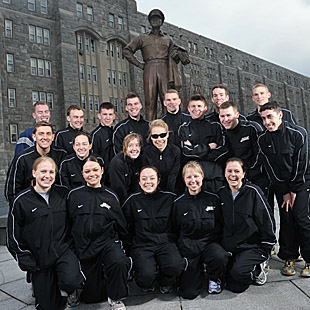
While triathlon will never draw the crowds that fill the Army-Navy football clashes, and her best current triathletes Nick Vandam and Ashley Morgan will never achieve the legendary status of All-American football players like Glenn Davis, Doc Blanchard and the godlike Pete Dawkins, the sport of swim-bike-run seems to have gained respect and traction for a number of reasons.
For one, the days of the Army football team’s three national championships (1914, 1944, and 1945) are long past. While Army’s Division I sports teams are in most cases outmatched by schools that recruit quasi-professional athletes, they have enjoyed great success with club teams. Such Academy teams won 2007 national titles in cycling and women's team handball, and in 2008 took titles in boxing, orienteering, men's team handball, and women's pistol. Now the Army Triathlon team has its sights set on joining their fellow club team champions.
In the past two years, Army Triathlon, thanks to the contributions and positive influence of team advisers Colonel Pat Sullivan, Colonel Ralph Vargas and majors Todd Brown and Andy Caine, started getting ambitious as crossovers from swimming, cross country, track and soccer gravitated to triathlon. In 2006, the West Point men’s triathlon squad finished 14th in Collegiate Nationals (behind Navy and ahead of Air Force), while the women placed 19th (behind Navy and Air Force). In 2007, led by Cadets Nick Dason (10th) and Nick Vandam (14th) Army men placed 3rd behind overall winner Navy, while the Army women, led by Ashley Morgan (19th) placed 9th as the Navy women won overall. In 2008, led by Vandam’s 11th place finish, a deep Army men’s team finished second to UC Berkeley while the Army women took 6th overall.
Under the guidance of 1991 West Point graduate Tony DeBoom, the men’s team, which last year had seven competitors who finished between 11th and 67th overall out of 700 entries, and whose times ranged from 1:59 to 2:08, have gotten appreciably sharper, faster and stronger. With a PR swim in the low 17 minutes, a 40k bike PR of 56 minutes and a target of a low 34 minute 10k, Vandam is dreaming of a podium, and possibly an overall win to help push his team to the national title. Top Army woman Ashley Morgan is fighting a painful heel plagued by plantar fasciitis, but is aiming at topping last year’s fourth place overall finish, and possibly the entire field.
But whatever the result, the quest of the men and women on the United States Military Academy Triathlon team has a fascinating part to play in the formation of the next generation of our nation’s military leaders during the wars in Iraq, Afghanistan and the global war on terror. In the coming week, this series will take a close look at the lives of triathletes and their coaches, mentors and role models to see how their sport of has become intertwined with the traditions and rigors that form The Long Gray Line.


